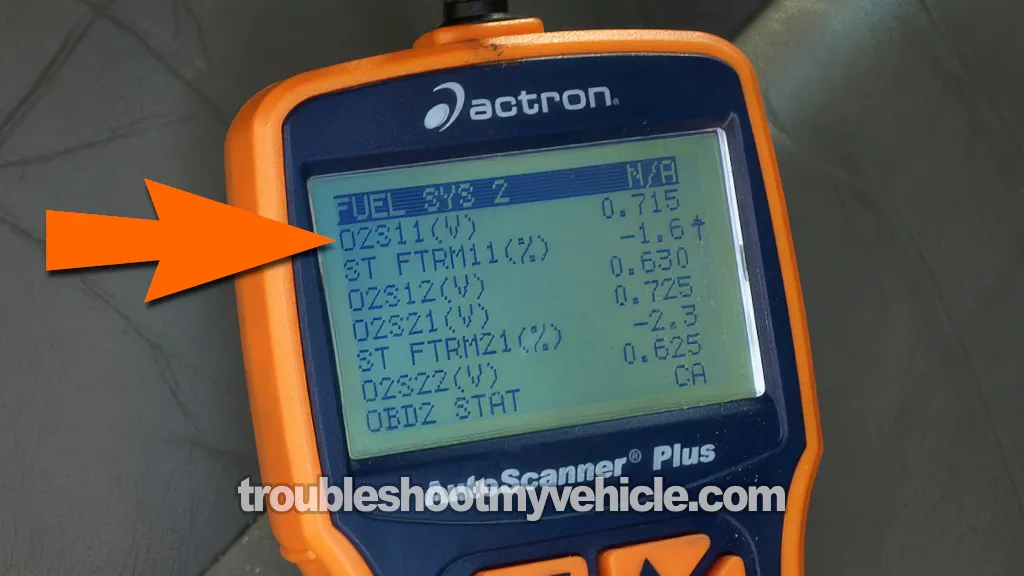TEST 2: Manually Inducing A Lean Condition

Just like we tested how the O2 sensor responds to a rich air/fuel mixture, we can also check how it behaves under a lean condition.
The easiest way to manually induce a lean mixture is by introducing unmetered air into the intake —and one of the most convenient spots to do this is by slightly loosening the large vacuum hose connected to the brake booster's check valve.
Due to its large diameter, this hose draws in a substantial amount of air when loosened, and that sudden increase in airflow will create a lean condition that your upstream O2 sensor should pick up right away.
IMPORTANT: Don't fully disconnect the vacuum hose from the brake booster, or the engine will stall.
All you need to do is loosen it just enough to allow some unmeasured air to enter —enough to lean out the mixture without shutting the engine off. You'll usually hear a faint hissing sound once it's loose enough.
IMPORTANT: Do a test run first (with the engine off) to loosen the vacuum hose. If it's never been removed before, it might be tight —and you don't want to be struggling with it while the engine is running.
Here's the step-by-step process for the lean test:
- 1
Start the engine and let it idle for about 15 minutes.
- 2
Connect your scan tool and switch to Live Data mode.
- 3
Find the oxygen sensor Parameter ID (PID) labeled O2S11.
- 4
Keep an eye on both sensor voltage readings.
- 5
Gently pull back or slightly loosen the large vacuum hose at the brake booster check valve.
Loosen it just enough to let in extra air. If you hear a soft hiss, you've done it right. - 6
Watch the O2S11 voltage values on the scan tool.
They should drop rapidly below 0.200 Volts —and in some cases, readings may fall as low as 0.050 Volts. - 7
Once you've seen the voltage drop and hold steady, push the vacuum hose fully back into place.
- 8
Give it a few seconds, and the voltage readings should return to normal —cycling between 0.100 and 0.900 Volts as they did before.
Now, here's how to understand your test results:
CASE 1: The O2S11 voltage dropped below 0.200 Volts when the hose was loosened. This means the upstream O2 sensor is working properly and accurately detecting a lean condition.
If you're still getting O2 sensor-related trouble codes, there's likely a different issue at play. Check out this next section: Oxygen Sensor Codes Keep Coming Back.
CASE 2: O2S11 voltage didn't fall below 0.200 Volts. That shows Bank 1 Sensor 1 (O2S11) isn't responding correctly to the lean mix —time to replace it.
Oxygen Sensor Codes Keep Coming Back
If you've made it to this part, chances are you've run the tests and everything's fine —or maybe you've already replaced the upstream O2 sensor. Yet somehow, the PCM is still throwing oxygen sensor codes.
In other words, the check engine light is back on, and you're still seeing those same O2 sensor-related trouble codes reappear.
When this happens, it's usually a sign that the engine is actually running too rich or too lean —but the oxygen sensor itself isn't really the problem.
To put it simply: something else is messing with the air/fuel mixture, and the O2 sensor is just picking up the symptoms —not causing them.
Here are some common troublemakers to consider:
- Weak fuel pump: If the pump can't maintain proper fuel pressure, the engine may run lean, which can cause the PCM to blame the O2 sensor. Your next step is to test the fuel pump:
- Leaking intake manifold gaskets: Allow extra air to enter without being measured by the MAP sensor, creating a lean mixture the PCM struggles to correct.
- Dirty or partially clogged fuel injectors: Can lead to fuel-starved cylinders that run lean, but the others run rich. This imbalance makes it difficult for the PCM to correctly compensate and fine-tune the air/fuel mixture.
- Failing MAP sensor: Sends incorrect intake manifold pressure data, skewing fuel calculations in either direction.
- Faulty engine coolant temperature (ECT) sensor: If it reports the engine as cold, the PCM may stay in open loop and over-fuel the system.
- Bad intake air temp (IAT) sensor: Wrong air temp data can mislead the PCM about how much fuel to deliver, upsetting the air/fuel mixture.
- Thermostat stuck open or wrong temperature rating: Keeps the engine too cool, which may trick the PCM into staying in rich mode longer than needed.
- Exhaust leak upstream of the O2 sensor: Lets outside air into the exhaust stream, making the sensor generate a false lean signal and causing the PCM to overcompensate with extra fuel.
Any of these issues can cause the PCM to incorrectly adjust the fuel trim —either adding too much fuel or not enough —which makes it seem like the oxygen sensor is malfunctioning when it's really just doing its job.
The tough part? These types of problems can come and go. If a component is only starting to fail, it might not misbehave during testing.
So what's the best approach? Be patient. Give the issue some time to become more consistent. Once it starts happening more regularly, your scan tool will have a much better chance of catching it in real time —and that's when you can finally zero in on the true cause and fix it for good.
More 3.9L V6 Dodge Ram Pickup Test Articles
I've written quite a few 3.9L V6 Dodge Ram pickup 'how to' tutorials. You can find all here:

If this info saved the day, buy me a beer!

